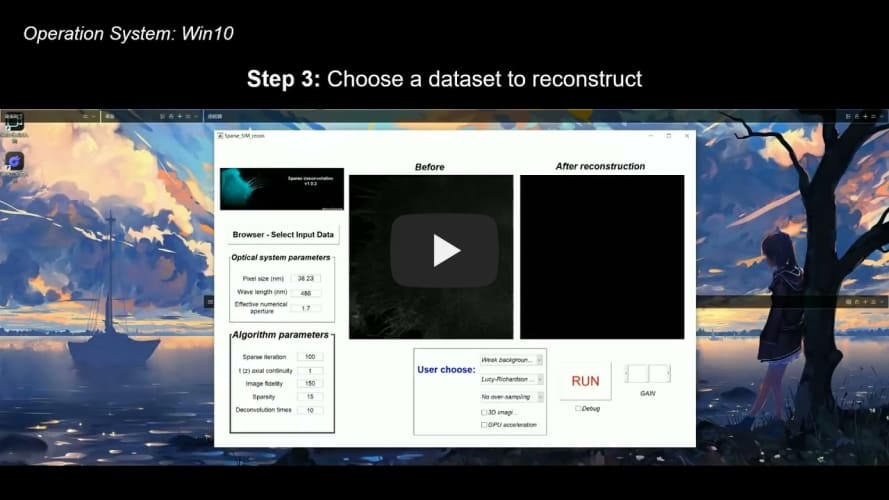Words written in the front: Physical resolution might be meaningless if in the mathmetical space.
It is a part of publication. For details, please refer to: Weisong Zhao et al. Sparse deconvolution improves the resolution of live-cell super-resolution fluorescence microscopy, Nature Biotechnology 40, 606–617 (2022).
The related Python version can be found at HERE
You can also find some fancy results and comparisons on my website.
If you are interested in our work, I wrote a #behind_the_paper post for further reading.
Here is also a blog about it for further reading.
This method has been tested on various types of Confocal microscopy & STED microscopy, Wide-field & TIRF microscopy, Light-sheet microscopy, Multi-photon microscopy, and Structured illumination microscopy, feasible for single-slice, time-lapse, and volumetric datasets.
This repository contains the updating version of Sparse deconvolution. The Sparse deconvolution is an universal post-processing framework for fluorescence (or intensity-based) image restoration, including xy (2D), xy-t (2D along t axis), and xy-z (3D) images. It is based on the natural priori knowledge of forward fluorescence imaging model: sparsity and continuity along xy-t (z) axes.
- The binary executable files (.exe/.app) can be found in the release
- More details on Wiki and Document.
- /src_unix is the source code for Unix-like systems (including MacOS).
- /src_win is the source code for Windows systems.
- Clone/download, and run the
Install.m - The input
Effective NAshould be given according to the sum ofillumination NAanddetection NA. For instances: wide-field is theobjective NA(e.g., 1.49); SIM is theillumination NA + objective NA(e.g., 1.3 + 1.7); SD-SIM is~1.8 * objective NA. - Please try help
xxxto get the API.
help SparseHessian_core
help background_estimation
help Fourier_OversampleThis software has been tested on:
- MATLAB R2017b on (Win 10: 128 GB and NVIDIA Titan Xp: 12GB; CUDA 9.1);
- MATLAB R2019b on (Win 10: 128 GB and NVIDIA Titan RTX: 24GB; CUDA 10.0);
- MATLAB R2019b on (Win 10: 16GB and NVIDIA GTX1050Ti: 4GB, CUDA 10.2);
- MATLAB R2015b on (CentOS 7: 64GB and Tesla K40 :12GB, CUDA 9.0);
- MATLAB R2018b on (Ubuntu 18.04: 16GB and NVIDIA TITAN Xp: 12GB, CUDA 10.1);
- MATLAB R2017b on (MacOS 10: 8GB without GPU acceleration).
More on Wiki.
- v1.0.3 Fully open source!
- v1.0.3 Another type deconvolution, and up-sampling methods, first officially released version!
- v0.6.3 Reorder the background estimation
- v0.6.2 Debug mode
- v0.6.1 Progress bar feature and logo
- v0.5.1 Up-sampling feature and change input file type from
.matto.tif - v0.4.1 Background estimation feature
- v0.3.0 Algorithm UI
- v0.2.0 Full model reconstruction
- v0.1.0 Sparsity reconstruction core
- Python version of Sparse deconvolution: sparse-deconv-py
- A light weight MATLAB library for making exsiting images to videos: img2vid
- An adaptive filter to remove isolate hot pixels: Adaptive filter imagej-plugin
- A tool for multi-color 2D or 3D imaging: Merge channels
- Further reading: #behind_the_paper & blog
- Some fancy results and comparisons: my website
- Preprint: Weisong Zhao et al., Extending resolution of structured illumination microscopy with sparse deconvolution, Research Square (2021).
- Reference: Weisong Zhao et al. Sparse deconvolution improves the resolution of live-cell super-resolution fluorescence microscopy, Nature Biotechnology 40, 606–617 (2022).
Plans
Open source Sparse deconvolution
- This software and corresponding methods can only be used for non-commercial use, and they are under Open Data Commons Open Database License v1.0.
- Feedback, questions, bug reports and patches are welcome and encouraged!















